Interested in growing your favorite tomatoes every year without buying new seeds? Tomato seed saving is the answer. By collecting and preserving seeds from your best tomatoes, you can ensure a steady supply of delicious and robust plants for future seasons.
I’ll walk you through the entire process of tomato seed saving. You’ll learn how to choose the best tomatoes for seeds, the importance of fermentation, and the steps to dry and store your seeds properly. Whether you’re dealing with heirloom varieties or curious about hybrids, I’ve got you covered.
Ready to become more self-sufficient in your gardening? Keep reading to discover how you can save tomato seeds and enjoy bountiful harvests for years to come.
- Related article: Learn How to Save Seeds
4 Key Takeaways on Tomato Seed Saving
- Saving tomato seeds is economical and helps you feel more connected to your garden.
- Hybrid tomato seeds can be unpredictable. Choose open-pollinated or heirloom tomatoes because their seeds stay true to their parent plants.
- Fermenting the seeds is important. It removes inhibitors and boosts disease resistance. After fermentation, sun-dry the seeds to prepare them for long-term storage.
- Properly stored tomato seeds can last up to 8 years.
Overview of Tomato Seeds: Why Save Them?
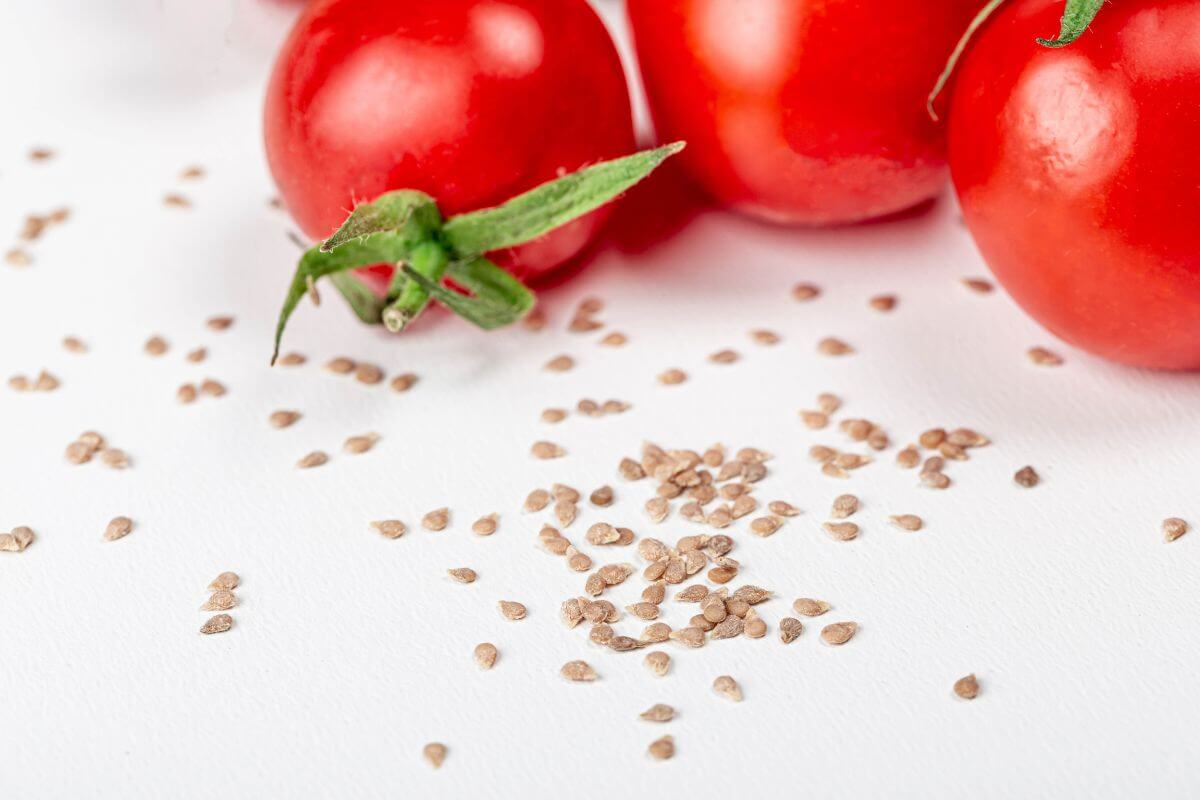
Tomato seed saving is the process of extracting, fermenting, and preserving seeds from ripe tomatoes for future planting. This involves choosing viable seeds from open-pollinated or heirloom tomato varieties because these produce seeds that grow true to their parent plants.
Saving seeds also helps keep different types of tomato plants growing well in your area. When you pick seeds from the strongest and most productive tomato plants, your tomatoes get better over time. This process makes sure that tomato plants do well in their specific environment.
Saving tomato seeds properly using a simple plan can produce strong tomato plants for several years. A key part of this is the fermentation process, which is essential for storing tomato seeds well. Fermentation helps by creating natural antibiotics that control seed-borne diseases, ensuring healthier plants.
Fermentation also helps form a protective seed coat, which stops seeds from germinating until they are planted. This step is very important and should not be skipped when saving tomato seeds.
Collecting and saving seeds from peppers is also common. I cultivate both peppers and tomatoes in my garden. Both types of seeds are easy to save and can yield a bountiful harvest season after season.
How to Save Tomato Seeds
If you’re looking to grow high-quality tomatoes and maintain them year after year, start saving tomato seeds. It’s easy — follow these steps.
Step 1 – Choose the Tomato for Their Seeds
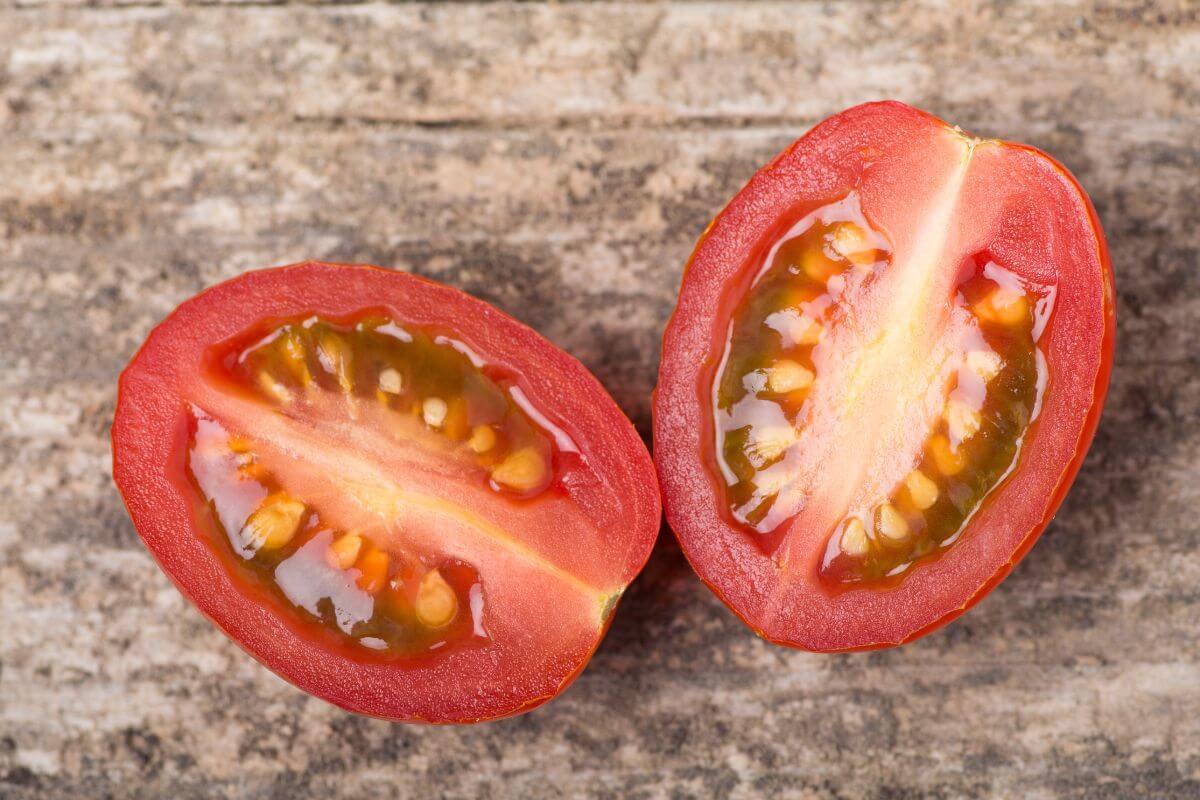
Wait for your tomatoes to turn red and you can then start choosing tomatoes you want to save seeds from in your garden.
Here are things you should consider when choosing tomatoes for their seeds:
- Choose open-pollinated or heirloom varieties, not hybrids, to ensure seeds grow true to the parent plant.
- Pick fully ripe, mature fruits from your healthiest and most productive plants to select for desired traits.
- Select tomatoes with the characteristics you want to preserve, such as flavor, size, color, or disease resistance.
- Select healthy tomatoes, and avoid seeds from diseased plants to prevent pathogen transmission.
- If growing multiple varieties, pick fruits from plants at least 10-50 feet apart to minimize cross-pollination.
- For rare varieties, gather fruits from different plants of the same type to maintain genetic diversity.
- Ensure selected tomatoes match the expected variety characteristics, avoiding any that appear unusual.
Step 2 – Wash and Cut the Tomatoes, then Remove the Seeds
To get good tomato seeds, keep everything clean. Wash the tomato well and let it dry. Cut it in half. Use a spoon or clean fingers to scoop out the seeds and the goo around them into a small jar.
This mix of seeds and goo is great for fermentation. Fermentation breaks down stuff around the seeds, making them healthier and easier to grow later on. It takes a few days for this to happen, but it’s worth it for better seeds.
Step 3 – Soak the Tomato Seeds
To soak tomato seeds successfully, you need to remove the gelatinous membrane covering them. This membrane protects the seeds when tomatoes drop naturally, but it must be removed before drying the seeds.
Here’s how you soak your tomato seeds:
- Place the seeds in a jar with water, using a ratio of about 3 parts water to 1 part seeds.
- Cover the jar with cling wrap and put it in a sunny spot.
- Let the sunken seeds soak for about a week. During this time, mold will start to form on top of the water.
This process will help you prepare the seeds for drying and storage.
Step 4 – Check to See if the Tomato Seeds Are Ready to Dry
After soaking the seeds, check if they are ready to dry by following these steps:
- Remove the Mold – The mold formed during fermentation is the smelly part. Take off the cling wrap and carefully remove the mold layer.
- Check Seed Readiness – If the seeds have sunk to the bottom, they are ready to be dried. If they are still floating, add a bit more water and cover the jar again for a few more days. The water might smell bad, but this is normal.
Optional Step: Treating Seeds to Prevent Disease
To prevent seed-borne diseases, you can treat the seeds with a bleach solution:
- Prepare the Solution: Create a 10% bleach solution by mixing water and bleach in a 9:1 ratio.
- Soak the Seeds: Soak the seeds in the bleach solution for 30 minutes.
- Rinse the Seeds: Strain the seeds and rinse them under cool water for at least 5 minutes to remove the bleach and residual chlorine.
This process helps ensure your seeds are clean and ready for storage.
Step 5 – Dry the Tomato Seeds
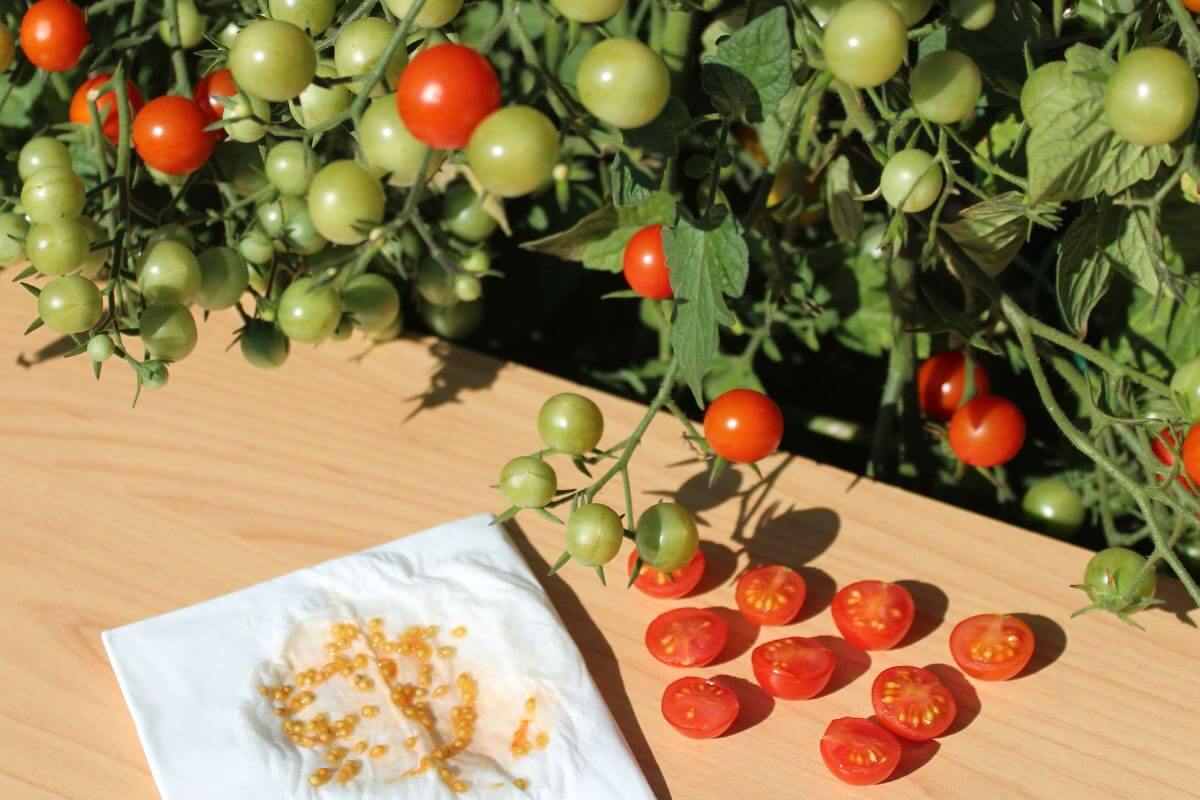
Once the seeds have all sunk to the bottom, they are ready to be dried. Follow these steps:
- Pour Off the Water – Carefully pour out the water from the container, making sure not to lose any seeds. Bad seeds will float, so you can pour off these floating seeds.
- Strain the Seeds – Pour the seeds and remaining water into a strainer or onto a window screen to dry. Drain off the excess water carefully.
- Dry the Seeds – Leave the seeds in a sunny, warm spot until they are completely dry.
You can also use a paper plate, paper towel, or coffee filter to dry the seeds, but be aware that seeds may stick to these surfaces. Be gentle when removing the seeds after drying.
Step 6 – Store the Tomato Seeds
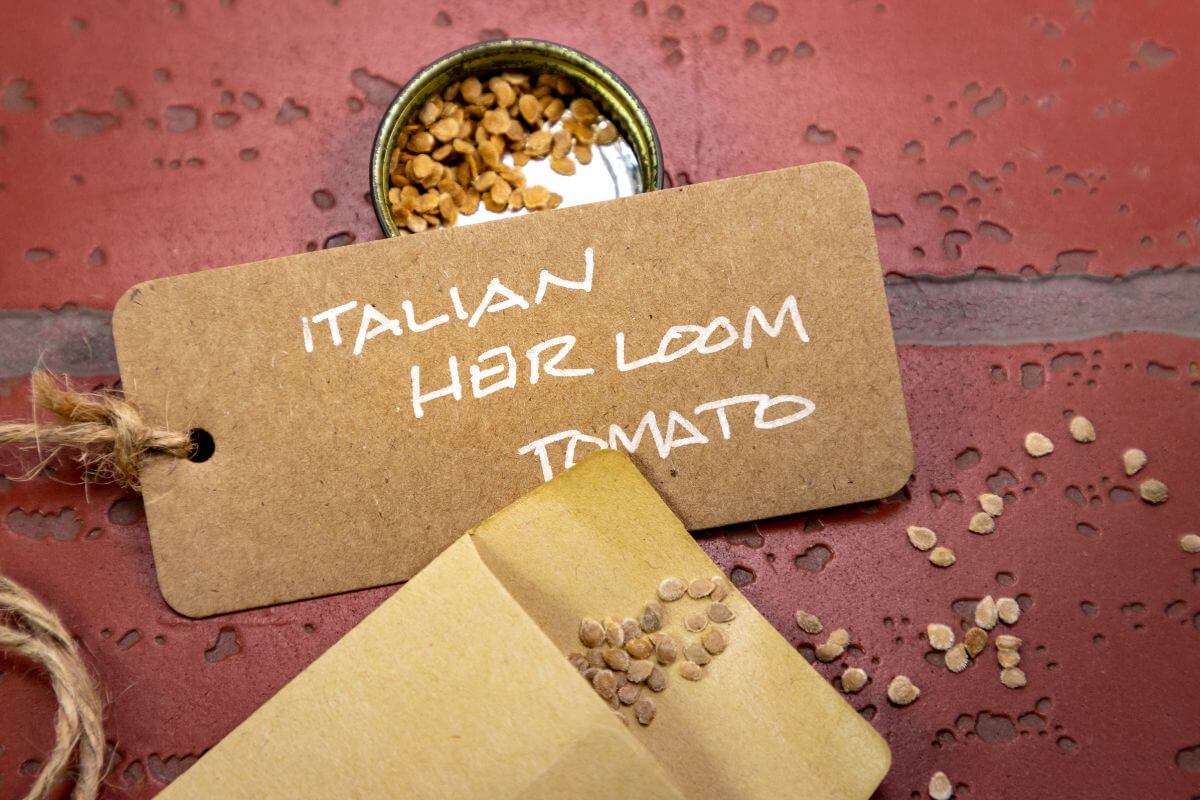
When your dry seeds are ready, it’s time to store them. Follow these steps:
- Package the Seeds – Place the clean, dry seeds into an envelope or paper bag. Label the package with the tomato variety and the current year.
- Optional Storage Options – You can use plastic baggies or an airtight container, but make sure the seeds are completely dry. Any moisture can cause condensation, so if this happens, take the seeds out and dry them longer.
- Choose a Storage Location – Store the seeds in a cool, dry place with minimal temperature fluctuations. Avoid direct sunlight and heat sources.
Properly storing your dry seeds will help maintain their viability for future planting.
How Long Will My Tomato Seeds Last?
Tomato seeds can last up to 8 years if you store them right. This means you can build up a good supply without needing to save seeds every year.
But I wouldn’t recommend just storing seeds without growing them. Growing and saving seeds each year helps you improve your skills and learn more about successful gardening.
Practical experience in growing your seeds makes you a better gardener. Just storing seeds for a rainy day won’t help much in the long run.
Can I Save and Grow Hybrid Tomato Seeds?
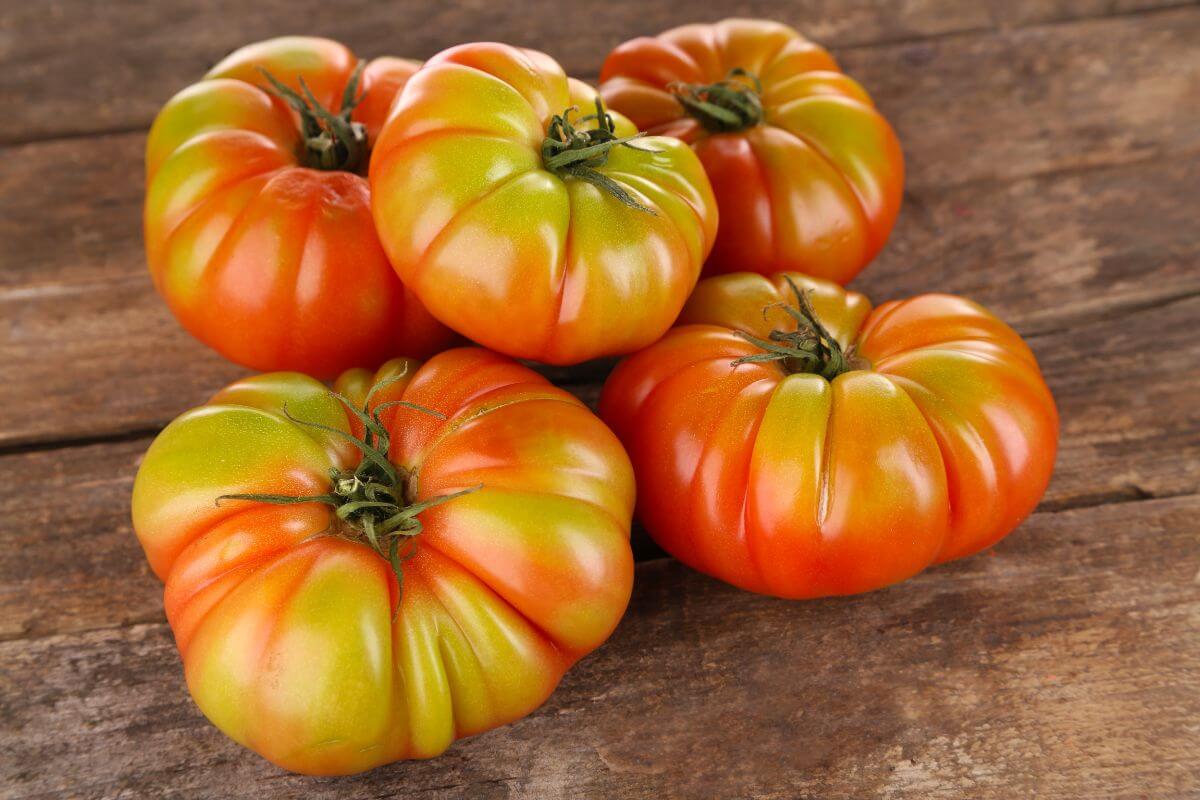
The answer to whether you can save seeds from hybrid tomatoes is both yes and no. It’s more challenging, but not impossible. Here’s what you need to know:
Some people find that seeds from hybrid tomatoes won’t germinate at all, while others have success. The outcome depends on the type of hybrid. Most seeds you buy are F1 hybrids unless stated otherwise.
If you buy an organic tomato from the store, you might successfully grow plants from its seeds. However, the tomatoes you grow may not be like the ones you bought because it’s likely a hybrid.
F1 hybrids are created by combining two different genetic lines through selective breeding and manual cross-pollination. The tomatoes you grow from these seeds may vary from plant to plant and might not retain the desired traits.
Growing from hybrid seeds means you don’t know what you’ll get until you plant fruits. Subsequent seeds from these plants can be even more inconsistent and change through generations.
If you have the space and enjoy experimenting, go ahead and try growing hybrid seeds. It can be a fun and educational process.
If you want a reliable crop that won’t change over the years, stick to open-pollinated and heirloom tomato varieties. These types are more stable and will produce consistent results.
Final Thoughts on Tomato Seed Saving
Saving tomato seeds is a smart move. It helps you save cash and grow plants that love your local weather. When you pick seeds from your best tomatoes, you’re keeping the good stuff going. These seeds will grow into strong, productive plants next year.
Look for the tomatoes that taste amazing and grow like champs. Those are the ones you want to save seeds from. It’s like picking the all-star team for your garden.
By doing this, you’re basically creating your own tomato superheroes. Each generation can get better at dealing with your garden’s quirks. And let’s be real, who doesn’t want a never-ending supply of their favorite tomatoes?
So next time you bite into a perfect tomato, don’t toss those seeds! They’re your ticket to an even better harvest next year. Ready to give it a shot?
The longer you save and replant the seeds, the stronger and more prolific your subsequent plants will be.
Tomato Seed Saving FAQs
1. Why Is Fermentation Important When Saving Tomato Seeds?
Fermentation breaks down gelatinous coatings around seeds, promotes healthier plants, and enhances seed storage capabilities.
2. How Long Can I Store Tomato Seeds?
Properly stored tomato seeds can remain viable for up to 8 years, but it’s advisable to grow and replenish seeds regularly for best results.
3. Can I Save and Grow Seeds from Hybrid Tomatoes?
Yes, but results can vary significantly as hybrid seeds may not produce offspring identical to the parent plant due to genetic variability.
For more guides on how to save seeds:

